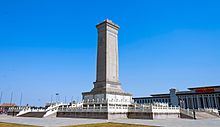Monument to the People's Heroes
This article needs additional citations for verification. (December 2020) |
人民英雄纪念碑 | |
 Monument from southwest, 2014 | |
 | |
| 39°54′11″N 116°23′30″E / 39.90306°N 116.39167°E | |
| Location | Tiananmen Square, Beijing, China |
|---|---|
| Designer | Liang Sicheng, Lin Huiyin |
| Type | Cenotaph |
| Material | Marble, granite |
| Height | 38 metres (125 ft) |
| Beginning date | August 1952 |
| Completion date | May 1958 |
| Dedicated to | Veterans of Chinese wars 1842–1949 |
The Monument to the People's Heroes (
The monument is 37.94 meters high, sitting south to north, from bottom to top for the pedestal, giant pedestal, the pedestal body, the top of the monument, the pedestal inlaid with eight large reliefs and two small reliefs, all to the theme of the major events of modern Chinese history. The center stone of the stele is taken from Laoshan Mountain, Qingdao, with "The heroes of the people are immortal" handwritten by Chairman Mao Zedong on the front, and the inscription written by Chairman Mao Zedong and Premier Zhou Enlai on the back. Since its construction, the monument has been repaired many times, and in 1961, the Monument to the People's Heroes was listed as a Major cultural heritage sites under national-level protection.
History
Preparation
After the liberation of
On September 24, 1949, a staff member of the CPPCC found the engraver Chen Zhijing in Liulichang, and ordered from him a copper lapis lazuli monument for laying the foundation stone, the pedestal was 2 feet high, the monument body was 5 feet high, 2 feet wide, and half a foot thick. on September 25, the monument's inscription was handed over by the staff member to Chen Zhijing and his brother. The monument was completed on September 29th. In the second day, the foundation stone laying ceremony for the monument was held in Tiananmen Square, with all the representatives of the first People's Political Consultative Conference (CPPCC) present. The foundation stone was laid by the People's Liberation Army Military Orchestra, which played the March of the Volunteers and Wind Chimes, after which Mao Zedong read the monument's inscription. Then, all the delegates and members of the CPPCC filled in the earth.
Description
The 37.94-meter (124.5 ft)-tall [
On the pedestal of the tablet are huge
- Destruction of opium at Humen (1839), in the run-up to the First Opium War
- Taiping Revolution(1851)
- Xinhai Revolution(1911)
- May 4th Movement(1919)
- May 30 Movement(1925)
- Nanchang Uprising(1927)
- War of Resistance Against Japan (1931-1945)
- Yangtze River Crossing Campaign of the Chinese Civil War(1949)
On the front of the monument is an inscription in Mao Zedong's handwriting, which reads, "Eternal glory to the people's heroes!" (Chinese: 人民英雄永垂不朽; pinyin: Rénmín yīngxióng yǒngchuí bùxiǔ).


On the back of the monument is an epitaph written by Zhou Enlai:[2]
Immortal Glory to the People's Heroes who laid down their lives in the People's War of Liberation and the People's Revolution in the past three years!
Immortal Glory to the People's Heroes who laid down their lives in the People's War of Liberation and the People's Revolution in the past thirty years!
Immortal Glory to the People's Heroes who, since the year 1840s, have given their lives in the many struggles to resist the enemy, domestic and foreign, to strive for the independence of the nation and the freedom of the people!
The time framing of since the 1840s was intended to encompass the China's modern history beginning with the Opium Wars, thereby framing the period of the 1840s to the 1940s as an anti-imperialist and revolutionary century.[2]
Commemoration

The conduct of commemoration activities at the Monument to the People's Heroes is regulated by the Major Events Administration Office of the Tiananmen Area Administrative Committee. Strict rules apply to conduct within the vicinity of the monument. Since the protests of 1989 (during which the Monument was a rallying point for the protestors), the government has prohibited climbing the monument beyond the protective barrier without prior approval, as well as photography and filming. Today, those intending to lay wreaths at the monument must apply five days in advance.[3]
Since 1980, it has been customary for visiting foreign dignitaries, especially from historical allies of the
See also
- History of Beijing
- Monument to the People's Heroes (Shanghai)
- China Millennium Monument
References
- ^ "The Monument to the People's Heroes". news.sohu.com (in Chinese). 2009-08-07. Retrieved 2021-07-28.
- ^ OCLC 932368688.
- ^ "Matters to note when paying respects or laying wreaths at the Monument to the People's Heroes". Major Events Administration Office of the Tiananmen Area Administrative Committee. 19 July 2002. Archived from the original on 5 December 2003. Retrieved 2021-07-28.
Further reading
- Hung, Chang-tai (2001). "Revolutionary History in Stone: The Making of a Chinese National Monument". The China Quarterly. 166: 457–473. S2CID 152288988.
